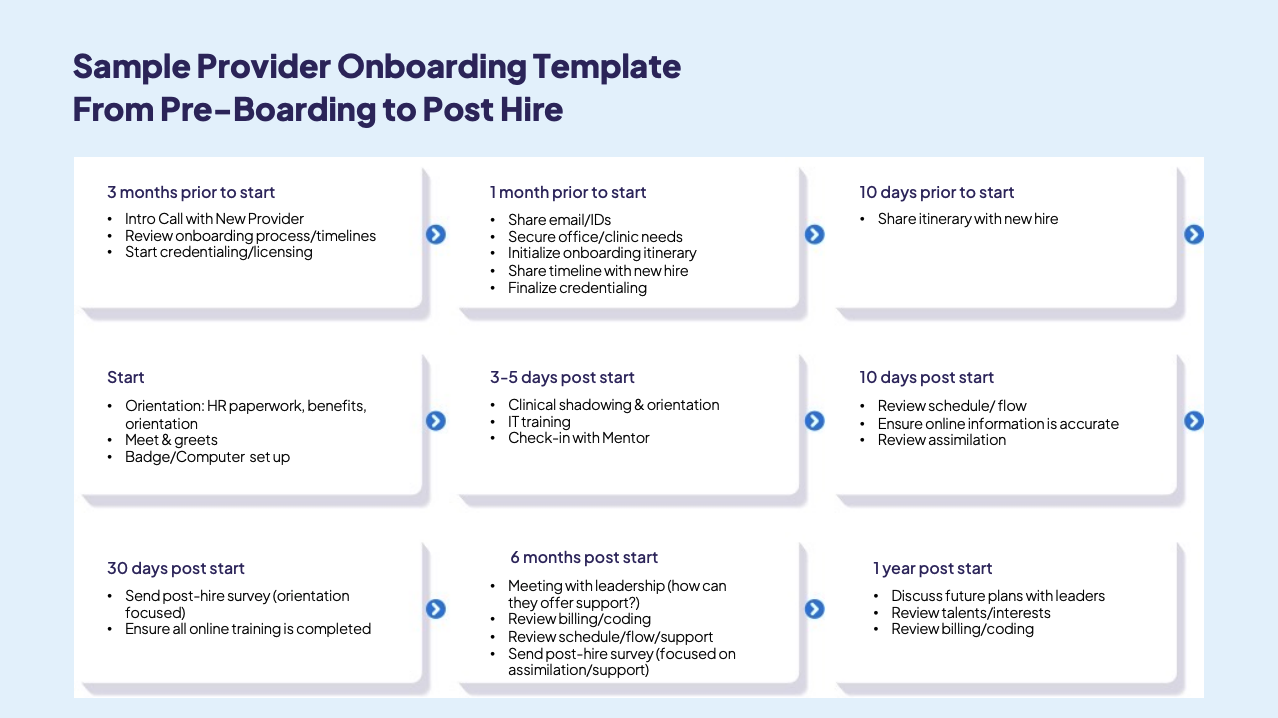Recent Posts
Most Popular
Crafting a Successful Healthcare Onboarding Program: Key Insights for Creating a Positive Provider Experience

Highlights
- Investing in a successful provider onboarding program is essential for healthcare facilities, improving retention, productivity and more.
- It’s not enough to have an onboarding program — your onboarding program should be an efficient, seamless experience for new providers.
- Common disruptors to the onboarding process include disjointed processes, unclear expectations and a lack of structure.
Introduction
In a recent webinar led by DocCafe executive vice president, Mike York, and renowned onboarding consultant, Donna Ecclestone, the hosts shared critical aspects of creating and enhancing provider onboarding programs for healthcare facilities.
Check out the webinar recap below to learn how to develop an onboarding program that efficiently integrates physicians and sets up new providers for long-term success. If you’d like to watch the webinar, you can access it on-demand.
What is onboarding?
Onboarding is more than a single day of orientation; it's a relationship-focused, experience-based activity that spans from recruitment and lasts up to a year. It involves fully integrating new providers into an organization's culture, role and community. While orientation is a short-term, task-focused component, onboarding is a longer, people-oriented phase in the provider life cycle.
It’s important to note that onboarding begins at recruitment — you should aim to keep open lines of communication and encourage new hires to ask questions from the day they accept their offer through their first year after joining.
Did you know?
During the webinar, 59% of attendees shared that they had an existing onboarding program and 41% did not. Which group do you fall into?
Why invest in onboarding?
Investing in onboarding goes beyond financial considerations. A successful onboarding program can:
- Improve engagement and productivity.
- Create a positive, lasting first impression.
- Minimize turnover and improve satisfaction.
- Increase efficiencies and reduce duplicative processes.
- Foster relationships to enhance cultural compatibility.
Data supports these benefits, highlighting that onboarding can increase retention by more than 50%1 and increase early productivity by more than 70%2. In fact, new hires are more than two times as likely to remain with a company for three or more years if they’re formally onboarded. And with the estimated cost of replacing a physician ranging from $250k to $1M-plus, it’s clear that onboarding programs aren’t just nice to have — they’re a necessity.
Common disruptors in the onboarding process
It’s not enough to have an onboarding program — your onboarding program should be an efficient, seamless experience for new providers. Inefficiencies in an onboarding program can lead to feelings of frustration and confusion for both new hires and current staff.
Some common disruptors include:
- Disjointed processes: Bouncing employees between departments and complex systems with no clear path.
- Lack of efficiency: Providers must resubmit the same info multiple times with too many manual processes.
- Unclear expectations: Providers don’t know what’s expected of them and when during their onboarding period.
- Lack of structure: A lack of alignment and formal program structure leads to inconsistencies.
Three key requirements of a successful onboarding program
Creating a standardized onboarding approach is a pivotal step in building effective onboarding programs. Let’s dive into the key elements involved in developing and implementing a standardized onboarding strategy.
Assemble a multi-disciplinary committee
Remember that onboarding is a team sport — hiring managers, HR teams, finance teams, compliance teams and peers all need to collaborate during the onboarding process. To get buy-in and encourage participation, you should involve employees across the system in developing, managing and improving your onboarding programs.
Establish uniformity
Create a global checklist and define a uniform progression of key tasks that will remain the same across every location. This checklist should span from recruitment to one or more years after the hire date.
By establishing a process that can be used globally across your organization, you’ll ensure there’s a strong foundation in place while still allowing individual teams and departments the freedom to customize specific program elements as needed. Your checklist should be flexible enough to accommodate these variations.
Promote accountability
Assigning responsibility within the onboarding process is crucial for accountability. Each task on a provider’s onboarding checklist should have a designated person or team responsible for its completion. This not only streamlines the onboarding workflow but also provides clarity regarding who to approach for each task.
To monitor progress over time, you can establish completion goals (e.g., the number of steps completed within 30 days) and share these reports with department chairs and managers monthly to promote transparency.
Additional recommendations for designing an onboarding program
Once you’ve got the building blocks of your onboarding program in place, you can work on fine tuning the specifics. Here are a few additional tips for designing your onboarding program:
- Ensure your program covers all the aspects of their responsibilities (clinical and non-clinical).
- Provide onboarders with the tools to execute the process (help your team help new hires!).
- Create companion resources like how-to guides, FAQs or other support resources that are easily accessible.
- Implement surveys to monitor onboarding efficacy (30 days and six months post-hire).
- Provide new hires with a condensed overview of your onboarding checklist outlining main tasks, approximate timeframes and the individual responsible for assisting.
Check out the sample roadmap below for a real-life example of what the onboarding process could look like for a new provider.

Setting up new hires for success
The first few days after a new provider starts are a crucial opportunity to make a positive, lasting impression — this period will typically include a new hire orientation. A sample itinerary for a new provider’s orientation itinerary could contain the following:
- Getting badge, parking, pager and building access.
- Providing training and access to the computer system, EMR and email.
- Introducing leadership, networking and reviewing policies, procedures, websites, referral contacts and compliance training.
- Touring the clinical site and other system sites/hospitals.
- Meeting with HR and senior leadership.
- Introducing the revenue manager, practice manager, nurse manager and physician liaison.
- Shadowing other providers.
Once orientation is over, you can focus on helping new providers assimilate into your organization’s culture. Remember: onboarding extends well beyond orientation. During the first six to 12 months of a provider’s tenure, you should:
- Provide consistent support: Providers are more likely to assimilate if they have consistent support and information about a system’s objectives and priorities.
- Set up peer mentoring programs: Pair new hires with mentors outside of their department to create broader connections.
- Prioritize early introductions: Try to make connections between new hires and other team members to help them feel more comfortable.
- Facilitate formal and informal interactions: Schedule optional meet and greets or plan a casual welcome lunch to help them build relationships.
- Connect with leadership: Solicit feedback by arranging appointments with various leaders over the first few months.
Recruit to retain: Tips to keep top talent for the long run
Retaining top talent is a continuous effort that extends beyond the initial onboarding phase.
By prioritizing retention, you can create an environment where top talent not only chooses to stay but actively contributes to the sustained success of your healthcare facility.
Here are a few ways to encourage retention and employee satisfaction:
- Ongoing recognition: Acknowledging and appreciating employees for their contributions on a regular basis can be a powerful retention tool. Implement a structured recognition and reward system that highlights both individual and team accomplishments. This could include celebrating work anniversaries, birthdays, exceptional efforts and achievements.
- Feedback loops: Establishing feedback loops is a great way to get a better understanding of the overall employee experience and address concerns promptly. Regular check-ins, performance reviews and open communication channels contribute to a culture of continuous improvement.
- Professional development opportunities: Providing avenues for ongoing learning and skill development can increase long-term job satisfaction. Consider offering mentorship programs, workshops, and access to resources that empower employees to expand their skill sets.
Conclusion
Creating a great onboarding program in healthcare goes beyond ticking boxes; it's about building something that truly shapes the future of your organization. Think of it like planting the seeds for long-term success: your onboarding efforts are not a one-time event but an ongoing relationship-building journey.
By understanding the key components of a successful onboarding program, you can create positive experiences for new providers and build a culture that nurtures and retains top talent.
References
- SHRM
- Brandon Hall Group
All information, discussions and opinions contained within this blog or otherwise on the website or any linked materials (“the “Blog Content”) is for general informational purposes only. All Blog Content is based on the author's opinions and experiences and is not necessarily representative of our opinions as an organization. It should not be considered as tax/financial advice, legal advice, compliance advice, health advice or other professional advice and does not constitute the practice of any medical, nursing or other professional healthcare advice, diagnosis or treatment or provision of legal services. You should seek professional assistance for any concerns or issues. If you or any other person has a medical concern, you should consult with your healthcare provider or seek other professional medical treatment immediately. While we strive to provide accurate and up-to-date information, we make no warranties or representations regarding the completeness, reliability, or accuracy of the Blog Content. Your use of the Blog Content is solely at your own risk and we will not be liable for any damages or losses arising from the use of, or reliance on, any Blog Content.





 Mike York
Mike York

Comments